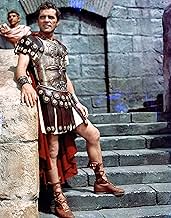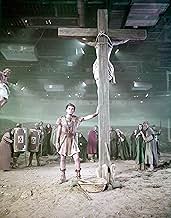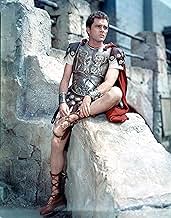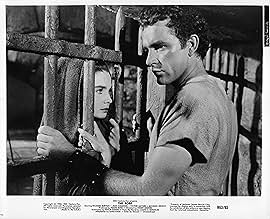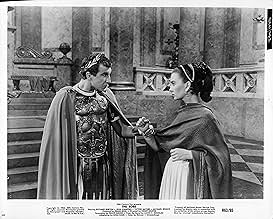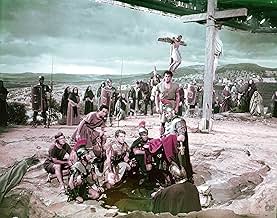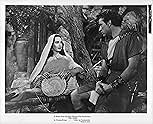Au cours du Ier siècle, dans la province romaine de Judée, le tribun romain Marcellus Gallio reçoit l'ordre de crucifier Jésus de Nazareth. Il est tourmenté par la suite par sa conscience co... Tout lireAu cours du Ier siècle, dans la province romaine de Judée, le tribun romain Marcellus Gallio reçoit l'ordre de crucifier Jésus de Nazareth. Il est tourmenté par la suite par sa conscience coupable.Au cours du Ier siècle, dans la province romaine de Judée, le tribun romain Marcellus Gallio reçoit l'ordre de crucifier Jésus de Nazareth. Il est tourmenté par la suite par sa conscience coupable.
- Réalisation
- Scénario
- Casting principal
- Récompensé par 2 Oscars
- 7 victoires et 6 nominations au total
- Citizen
- (non crédité)
- Judas
- (non crédité)
- Slave Dealer
- (non crédité)
- Citizen
- (non crédité)
Avis à la une
The story of Christ on film is more important historically than may at first might appear. At either two or three reels, the first ever full "feature film" is arguably claimed to be the "The Passion Play" (1898), filmed in New York in 1897. The 'greatest story ever told' has hit the screen regularly thereafter, perhaps most famously in recent years with Mel Gibson's masterly personal tribute, "The Passion of the Christ" (2004).
I will now comment briefly on some of the technical and visual aspects of "The Robe". The camera work majors on long shots, and it is interesting to analyse how each shot is framed for all that width of screen. The camera is mostly static, and shots have longer than average duration; the compositions really are not designed for a lot of movement. This gives the film that famous "epic" style that goes for the grand sweep, both visually, musically and emotionally. There is not a lot of internalisation within the characterisation - it is the (literal) width and scope of the production that grabs attention. The filmic style is not very personal, however. It really is as if we have the best seats in an outdoor drama on a massive stage.
As you view, you may wish to make a note of the shots that seem to work best to the modern viewer. In the early part of the film, for instance, (just before the "Passion" sequence), Demetrius runs toward the camera in search of Jesus, after he's been beaten down by the Roman guards outside the gates of Jerusalem. An old lady sitting behind him on the cobbled pathway, has just finished tending his wounds. The shot is terrific, and works for modern audiences very well. Unlike a lot of the film, where much of the direction seems to be subjected to the demands of the CinemaScope process, this shot contains a dynamism that beguiles the film's age. Why? Because it uses the three dimensions of the set, along with arresting and dramatic movement, as Demetrius runs diagonally toward the camera and beyond us, toward the Crucifixion, which we see in the next sequence.
Another sequence that really works well is the chase in the second half. It is arguably the most dramatic sequence in the entire picture, and certainly uses CinemaScope to best effect, as the horses thunder toward the audience. Over fifty years later, and it would be hard to better.
By contrast, most of the film is played out in tableaux form, with action taking place across the width of the screen on lavish but shallow sets. The camera is a passive observer, unlike modern 'epics', which usually use very fluid camera set-ups along with computer-generated imagery (CGI). The actual crucifixion (masterful in what it does not show, by the way) is indeed an actual still life tableau, and could have easily been lifted straight out of the Oberammergau passion play. I do not say this to put the film down - this actually is a brilliant move, as it makes the action faithful to the genre of the passion play, which originally was played out exclusively through short tableaux.
In this writing, my aim has been simply to help you consider alternative ways of viewing this, and other, historic motion pictures. Particularly, you may wish to take note of the sometimes unusual way the film uses: (a) framing, (b) shot length, (c) staging, (d) camera movements, (e) the use (or rather, the almost total lack of use) of close ups and 'cut-away' shots, (f) lighting, and the (g) music score and dialogue. Of course, there is much more to note: the use of dissolves and fades, which helps underline the 'epic' grandeur of every sequence. And I've not even touched on the story line or the acting. (Question: how might it have played as a silent movie?)
In today's post-modernist society, the Passion play formula, with its emphasis on objective truth, may well gain renewed importance, since the narrative of Christ's passion may be in danger of becoming yet one more voice crying in a commercial wilderness devoid of ultimate human (and Godly) values of truth, goodness and conviction. The story of Jesus stands out as unique however it is viewed. The simple reason: the story of the Passion indeed IS unique! (Which is one reason why I consider it a 'genre' in its own right.) I contend, therefore, that "The Robe" is an important contribution to American cinema, both theologically and cinematographically; one among a select number of motion pictures, spanning over one hundred years of history, that every student should have opportunity to view and discuss at least once whilst still in full time education.
A sidebar: "The Robe" really needs to be watched in 'letterbox' (i.e. in the original format), which on a small display does not do the picture justice. With HDTV coming along, look out for a digital re-release that will restore the original to its pristine glory. (Also, a side-by-side comparison with the Academy format version - shot at the same time - would be beneficial.) Best of all, of course, arrange to get it screened in your local art house cinema, and see it as it is meant to be viewed: on the big screen.
If there is one failing with the story, and it is a minor one, Emperor Tiberias is presented as an honorable ruler and not as the depraved lecher he really was. He only comes off looking as well in history as he was because his grandson Caligula was so much worse.
Today the slave market is crowded because the emperor's heir and regent, the young Caligula (Jay Robinson) is coming to buy gladiators He probably will not be pleased to see Tribune Marcellus Gallio
Marcellus (Richard Burton) forgot the promise he made to Diana (Jean Simmons) to marry her when they grew up They were friends many years ago when they were children Now, since her father death, Diana has been the ward of the emperor and his wife Empress Julia (Rosalind Ivan) thinks she could be good for Caligula
At the auction, Caligula leaves the place very angry Marcellus buys a rebellious Greek with the name of Demetrius (Victor Mature) to be his personal attendant
Few hours later, Marcellus pays the consequences for humiliating Caligula, and is ordered to the garrison at Jerusalem, the worst pest-hole in the empire where the people are always on the verge of rebellion Caligula hoped by this order to give Marcellus his death sentence Senator Gallio (Torin Thatcher) asks his son Marcellus to be above all a Roman and a man of honor
On the deck before the galley set sail to Palestine, Diana appears to tell Marcellus that she's going back to Capri to ask the emperor to intercede for him Marcellus didn't believe that a girl of 11 could fall in love and stay in love all these years
All the spirit of the age is present in Koster's epic: The wilderness of the land of Galilee; the massage relaxing area; the terrifying meeting of Demetrius with one of Jesus' disciples; the Roman procurator of Judea asking to wash his hands more than once; the tribune's first battle trophy, for victory over the king of the Jews; the spectacular sword fight between two officers of the empire; and a lost robe in the hands of a runaway slave...
Richard Burton is the brave Tribune who renews his pledge of loyalty to his emperor and to Rome; Jean Simmons is lovely as the exquisite maiden who stands firmly besides her love; Victor Mature is brave and spirited as the Greek slave; Michael Rennie is serious and profound in thoughts and manners as Simon the Galilean; Jay Robinson is terrific as the vicious, treacherous young Caligula drunk with power; Dean Jagger is full of devotion and reverence as the humble and honest Justus; Ernest Thesiger is efficient enough as the austere Tiberius; Betta St. John is so sweet as the disabled believer Miriam; and Torin Thatcher is too helpless as the proud Senator
It is notable that Jesus of Nazareth is seen from far away riding a white donkey with all the people around carrying palms and as a tortured figure, impossible to discern lying beneath the heavy cross... Henry Koster restraints with dignity the recreation of the execution carried out at Calvary, outside Jerusalem...
Le saviez-vous
- AnecdotesRichard Burton was once threatened with a gun by Stewart Granger because of the affair he was having with Granger's wife Jean Simmons during filming.
- GaffesCaligula is depicted here and in the sequel Les gladiateurs (1954) as persecuting Christians. However, he reigned from 37 to 41, while Christianity was still a nascent religion with most of its followers in the eastern Mediterranean. The first mention of Christians from the perspective of the Roman government, according to the Roman historian Suetonius, wasn't until the reign of his successor Claudius (reigned 41-54). The first major incidents of persecution of Christians did not occur until the reign of Nero (54 to 68).
- Citations
Diana: [Marcellus has just been sentenced to execution; Diana leaves the podium to stand at his side] Sire, Marcellus is my chosen husband. I wish to go with him.
Caligula: Stand back! You're not on trial! There's no evidence against you!
Diana: Then if it please you, sire, I'll provide evidence. I have no wish to live another hour in an empire ruled by *you*! You dare to call yourself a Caesar. Once the Caesars of Rome were noble, but in you, noble blood has turned to poison. You corrupt Rome with your spite and malice.
Caligula: Stop! Stop it!
Diana: That *you* should be Caesar, vicious, treacherous, drunk with power, an evil, insane monster posing as emperor.
Caligula: STOP IT!
Diana: As for me, I have found another king. I want to go with my husband into his kingdom.
Caligula: Then, by the gods, you shall! Go, both of you, into your kingdom!
- Versions alternativesIn 1997 the opening credits were altered to give top writing credit to Albert Maltz. Maltz had written the initial screenplay when the project was at R.K.O. Maltz's credit did not appear on prior prints because he was one of the "Hollywood Ten" who was blacklisted.
- ConnexionsFeatured in Les gladiateurs (1954)
- Bandes originalesThe Resurrection
Composed by Alfred Newman
Vocal performed by Carol Richards
Betta St. John onscreen as Miriam, lipsyncing
Meilleurs choix
- How long is The Robe?Alimenté par Alexa
Détails
Box-office
- Budget
- 5 000 000 $US (estimé)
- Montant brut aux États-Unis et au Canada
- 36 000 000 $US
- Montant brut mondial
- 36 010 866 $US
- Durée
- 2h 15min(135 min)
- Couleur
- Rapport de forme
- 2.66 : 1


